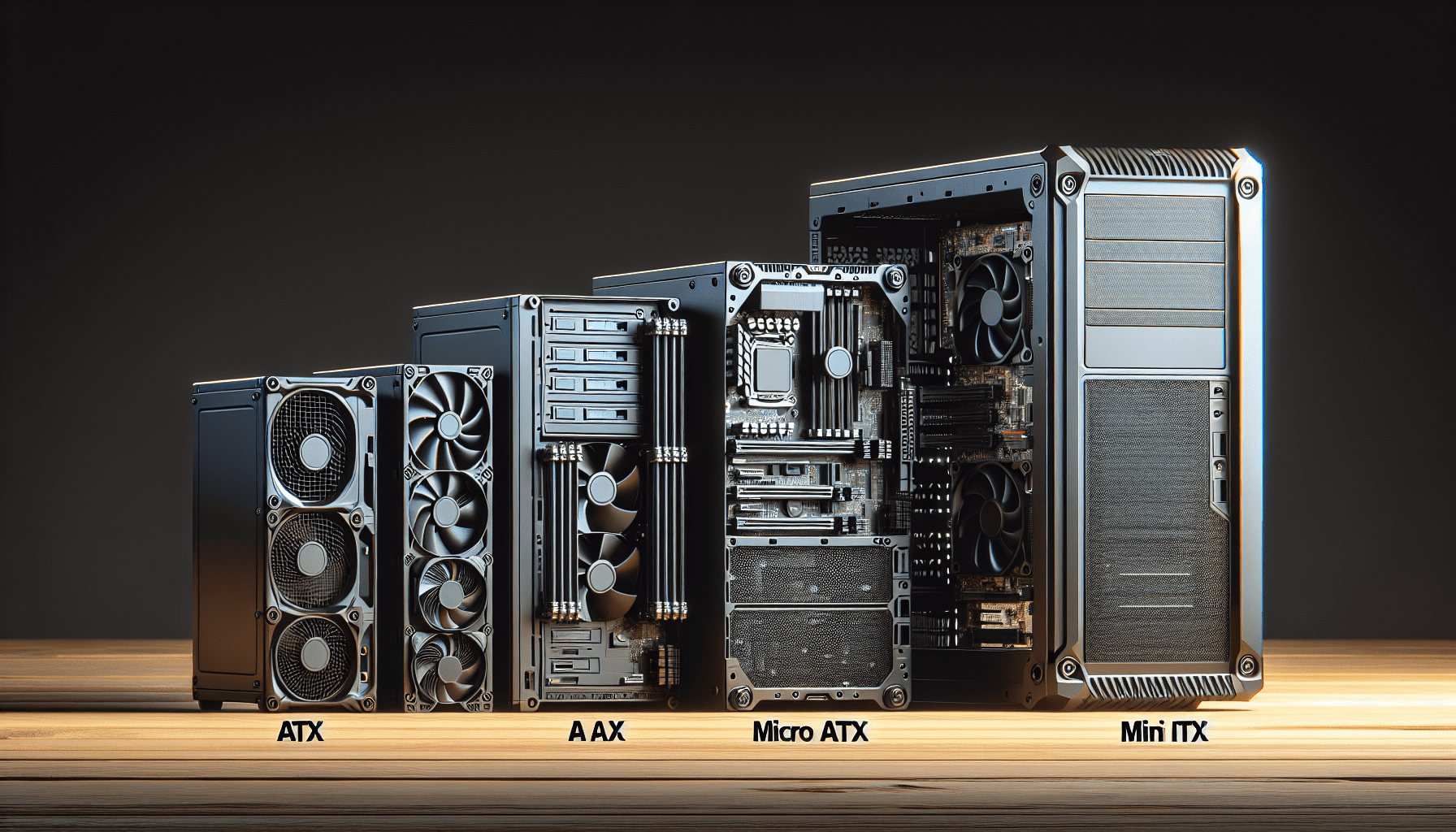So you’re ready to build your own PC, but you find yourself facing a crucial question – how do you choose the right size ATX case? With so many options out there, it can feel overwhelming, but fear not! In this article, we’ll break down the key factors you need to consider when selecting the perfect ATX case for your PC build. From motherboard compatibility to cooling options and future expansion, we’ve got you covered. Get ready to embark on this exciting journey of choosing the right ATX case that will house your dream PC.
Consider the motherboard size
When choosing an ATX case for your PC build, one of the first things you need to consider is the size of your motherboard. There are three commonly used motherboard sizes: ATX, Micro ATX, and Mini ITX.
ATX
ATX (Advanced Technology Extended) is the most common motherboard size used in desktop PCs. It offers a good balance between expansion capabilities and form factor. ATX motherboards are larger in size compared to Micro ATX and Mini ITX, allowing for more slots and connectors. If you plan on using multiple expansion cards or need additional ports, an ATX case would be a suitable choice.
Micro ATX
Micro ATX is a smaller form factor than ATX, but it still offers a decent number of expansion slots and connectors. If you’re looking to build a compact PC without compromising too much on functionality, a Micro ATX case would be a good option. Micro ATX cases are generally easier to transport and take up less space on your desk.
Mini ITX
Mini ITX is the smallest motherboard form factor commonly used in desktop PCs. It is specifically designed for compact builds where space is limited. While Mini ITX motherboards offer fewer expansion slots and connectors compared to ATX and Micro ATX, they are perfect for building small, portable PCs. If size and portability are important factors for you, a Mini ITX case would be the way to go.
Evaluate the internal and external dimensions
The dimensions of the ATX case are crucial to ensure it can accommodate all your components and fit in your desired space. Consider the length, width, and height of the case.
Length
The length of a case determines how long of a graphics card it can support. If you plan on using a high-end, longer graphics card, make sure the case has enough length to accommodate it without any clearance issues. It’s also important to check if the length of the case fits in the designated space in your setup.
Width
The width of the case determines how many expansion slots and drive bays it can accommodate. If you have multiple expansion cards or need several drive bays for storage, a wider case would be suitable. However, if you’re looking for a compact build with fewer components, a narrower case would be more appropriate.
Height
The height of a case is crucial for determining its overall size. If you have limited vertical space in your setup, a taller case might not be the best choice. On the other hand, if you have ample space and want to maximize airflow and cooling options, a taller case with more room for fans or liquid cooling components would be beneficial.
Determine the number of drive bays required
Drive bays are essential for installing additional storage drives such as hard disk drives (HDDs) or solid-state drives (SSDs). Consider the number and type of drive bays required for your storage needs.
3.5-inch drive bays
3.5-inch drive bays are commonly used for traditional HDDs, which offer high storage capacity at an affordable price. If you have multiple HDDs or need significant storage space, make sure the case has enough 3.5-inch drive bays to accommodate your requirements.
2.5-inch drive bays
2.5-inch drive bays are used for SSDs, which provide faster data transfer speeds compared to HDDs. If you plan on using SSDs as your primary storage or require additional SSDs for caching or specific applications, check if the case has enough 2.5-inch drive bays.
5.25-inch drive bays
5.25-inch drive bays are versatile and can be used for various purposes such as optical drives, fan controllers, or additional front panel ports. However, with the declining popularity of optical drives and the availability of external port hubs, the number of necessary 5.25-inch drive bays has reduced for most users. Consider your specific requirements before choosing a case with 5.25-inch drive bays.
Check for expansion slots
Expansion slots are essential for adding additional components like graphics cards, sound cards, or networking cards to your PC. It’s essential to check the number and type of expansion slots available in the ATX case.
PCI slots
PCI slots are the most commonly used expansion slots in desktop PCs. These slots are used for various expansion cards such as graphics cards, sound cards, or Wi-Fi adapters. If you plan on using multiple expansion cards or require specific functionality, ensure that the case has enough PCI slots to accommodate your needs.
GPU clearance
If you’re using a powerful graphics card, it’s crucial to check the GPU clearance of the ATX case. High-end GPUs tend to be longer and taller, and not all cases can accommodate them. Ensure that the case has enough clearance for your graphics card to avoid any fitting or airflow issues.
Consider cooling options
Proper cooling is essential for the longevity and performance of your PC components. Consider the cooling options available in the ATX case.
Number of fans
Fans are the most common cooling solution for PC cases. Look for a case that offers enough fan mounts to keep your components cool. Consider the size and number of fans you want to install and ensure that the case can accommodate them.
Liquid cooling support
Liquid cooling, also known as water cooling, provides superior cooling performance compared to air cooling. If you plan on using liquid cooling for your CPU or GPU, make sure the case has enough space for radiators, pumps, and reservoirs. Look for mounting points and compatibility with standard liquid cooling components.
Assess cable management capabilities
Efficient cable management not only improves the aesthetics of your build but also helps with airflow and maintenance. Consider the cable routing options and space for cable management available in the ATX case.
Cable routing options
Look for cases that provide ample cable routing options, such as routing holes, grommets, or channels. These features make it easier to route and hide cables behind the motherboard tray, resulting in a cleaner and more organized build. Good cable routing also improves airflow and makes future maintenance or upgrades hassle-free.
Space for cable management
Check if the case has enough space behind the motherboard tray or dedicated cable management compartments to store excess cables. Sufficient space allows you to tuck away cables neatly, preventing them from obstructing airflow or interfering with other components.
Evaluate the design and aesthetics
The design and aesthetics of the ATX case play a significant role in the overall look of your PC build. Consider your personal preferences and the appearance you want to achieve.
Windowed panels
Windowed panels allow you to showcase your components and RGB lighting, providing a visually appealing look. If you’re proud of your hardware choices or have invested in RGB components, consider a case with a windowed panel. However, if you prefer a more minimalistic or professional appearance, a solid panel case might be a better fit.
RGB lighting
RGB lighting is a popular trend in PC building, allowing you to customize the lighting effects and colors of your components. If you want to create a vibrant and eye-catching build, look for a case that offers built-in RGB lighting or ample space for RGB fans or LED strips. However, if RGB lighting is not your preference, you can opt for a case with subtle or no lighting options.
Consider future upgrades and compatibility
Future upgrades and compatibility are crucial factors to consider when selecting an ATX case. Ensure that the case provides enough space and compatibility for your potential upgrades or newer hardware releases.
Space for additional components
Consider if the case has enough physical space to accommodate additional components you may want to add in the future. These components could include extra drives, larger graphics cards, or additional fans for improved cooling. Choosing a case with room to grow ensures that you won’t have to replace the entire case when you decide to expand or upgrade your build.
Compatibility with future hardware
Technology evolves rapidly, and it’s essential to choose a case that can accommodate future hardware releases. Check if the case supports the latest motherboard form factors, has enough clearance for future graphics cards, and includes sufficient USB and other connectivity options. This ensures that your case won’t become obsolete when you decide to upgrade your PC components.
Determine the weight and portability
The weight and portability of the ATX case are factors to consider, especially if you plan on frequently transporting your PC or have limited space available.
Weight of the case
Consider how often you need to move your PC or if you have limited strength for lifting heavier cases. The weight of the case can vary significantly depending on the materials used and the features included. If portability is essential to you, consider a case made from lighter materials such as aluminum or opt for a more compact and lightweight Mini ITX case.
Handle or grip options
Some cases come with built-in handles or grip options, making it easier to carry or transport your PC. These features are especially beneficial if you frequently attend LAN parties or need to move your PC between different locations. If portability is a priority, look for a case that offers convenient handles or grips.
Consider budget and pricing
Budget and pricing play a significant role in selecting the right ATX case. Consider the overall cost and value for money when making your decision.
Compare prices
Before making a final decision, compare the prices of different ATX cases that meet your requirements. Prices can vary depending on the brand, features, and build quality. Look for the best balance between price and the features you need.
Evaluate the value for money
While budget is an important consideration, it’s equally important to evaluate the value for money offered by the case. Consider the build quality, included features, reliability, customer reviews, and warranty when assessing the overall value for your investment.
In conclusion, choosing the right size ATX case for your PC build involves considering factors such as motherboard size, internal and external dimensions, drive bays, expansion slots, cooling options, cable management, design and aesthetics, future upgrades and compatibility, weight and portability, as well as budget and pricing. By carefully evaluating each aspect, you can select a case that meets your requirements, suits your build, and provides an enjoyable and functional PC experience.

